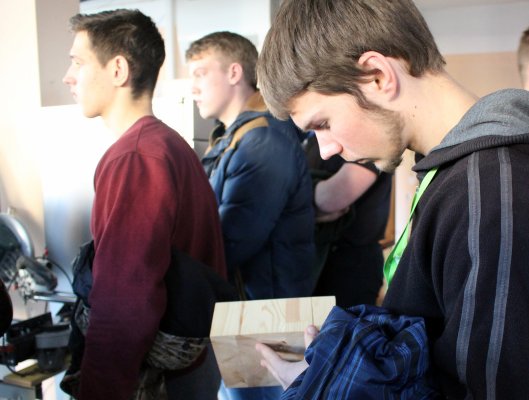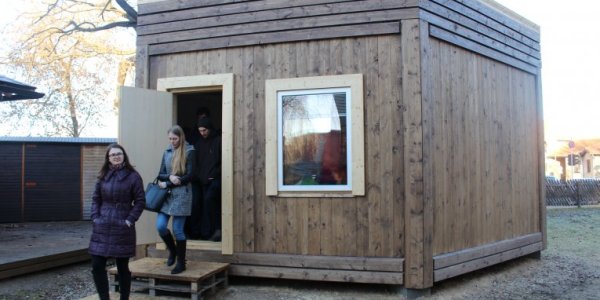LVM scholarship winners learn about trees from another point of view
Shortly before the end of the year, LVM scholarship winners as a delegation visited the laboratories of the Research and Development Institute of Forest and Wood Processing (MeKA), to get acquainted with the work done by LVMI “Silava”, as well as latest information about forest resources and forestry development in Latvia. Students learnt about trees as a useful material in the construction of complicated and functional buildings, and, when visiting IKTK (Innovations in Wooden Bridges and Structures) production facility, they found out that wood processing in Latvia is of high quality. Besides large glued wooden structures, from this place also originates Latvia's largest wooden pedestrian bridge – a laboratory that is situated in LVM Nature Park in Tērvete.
At first, LVMI “Silava” Director Jurģis Jansons introduced students with forest resource dynamics in Latvia and National Forest Monitoring data acquired using the forest statistical audit method, and talked about the significance of betterment in forests, as well as other matters related to forestry development.
Students actively participated in a discussion on forest management and tree breeding. “Historically, Latvia has been a land of forests. There is an issue – either we perceive the forest as a non-renewable or fossil resource, that is to say we only “take”, or we talk about the forest as a renewable resource, which provides high-grade wood in a short period time, following active and proper management,” says Jurģis Jansons, pointing out the importance of betterment in forests, as it ensures a moving water. Only oxygen in moving waters provides trees with the necessary nutrients and microelements in an absorbable state.
MeKA Director Andrejs Domkins spoke with students, telling them about innovations in wood production, which ensures value added for timber. In MeKA laboratories, students had an opportunity to observe construction and furniture testing devices. Using special devices, it is possible to test structure deflection, elasticity, and pressure. Laboratories also carry out fire reaction tests on specific structures and floor materials, as well as biomass tests by determining humidity, ash amount, bulk density, and calorific value. “We can provide any test that a customer wants, including furniture and surface quality testing and functionality,” says A. Domkins.
A house – from wood, a bridge – from wood
Uldis Spulle, MeKA Deputy Director for scientific work, told students about the positive attributes of wood that make it not only a modern and functional interior element, but also a high-grade and endurable construction material, whose use is becoming increasingly high in the world. Nowadays, there are both solid wood log houses and modern wooden skyscrapers. Contrary to conventional construction methods that are based on the “wet method”, which takes longer time on building sites, wooden structures that are based on the “dry method” are built in a comparatively short period of time and are supplied to construction sites for immediate installation. In this way, one can also efficiently insulate facades, thus saving time and leaving the building's residents undisturbed.
Considering its natural properties, properly used wood becomes an irreplaceable material in construction. For example, a fir-tree in wooden structures is a useful construction material due to its “memory” – with variable loads (snow on roof), it can return to its original shape over the course of seasons. Pine-tree as a material should be used for windows and doors.
Wooden bridge for pedestrians – a laboratory in Tērvete
Finally, students visited IKTK company's factory, where following constant air temperature and humidity (which are automatically adjusted in the facility) is essential in the making of glued large-scale multidimensional wooden structures.
Qualified specialists mark the inadmissable flaws and branches on planks with a marker. These marks are detected by sensors, and the irrelevant segments are cut out. “We are using technology and glue, and the glued parts are repeatedly tested day after day. The glued seams of these planks cannot break,” says director Gatis Eglītis.
This time, the factory has manufactured a wooden bridge for pedestrians – a laboratory over a highway that is situated in Tērvete. It contains sensors that detect various changes, such as humidity in various depths.




















